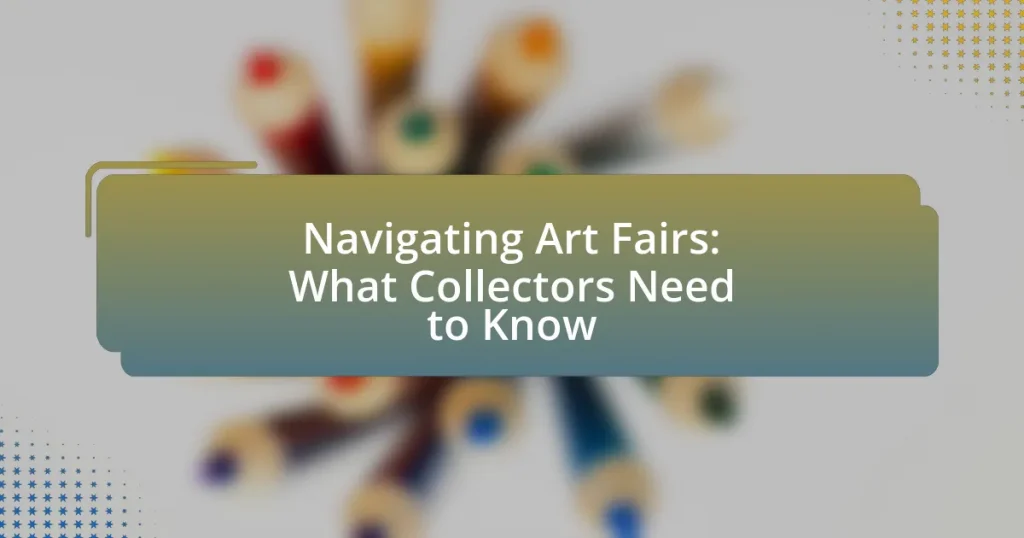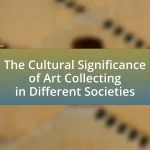Art fairs are organized events where galleries and artists present and sell artworks, playing a crucial role for collectors by offering access to diverse pieces and networking opportunities. This article outlines the significance of art fairs, detailing how they differ from other art events, the types of artworks available, and their contributions to the art market. It also provides practical advice for collectors on preparation, budgeting, and effective navigation of these events, as well as insights on assessing artwork value and maintaining relationships with galleries and artists post-fair. Collectors will gain a comprehensive understanding of how to maximize their experience at art fairs and the benefits of engaging with the art community.
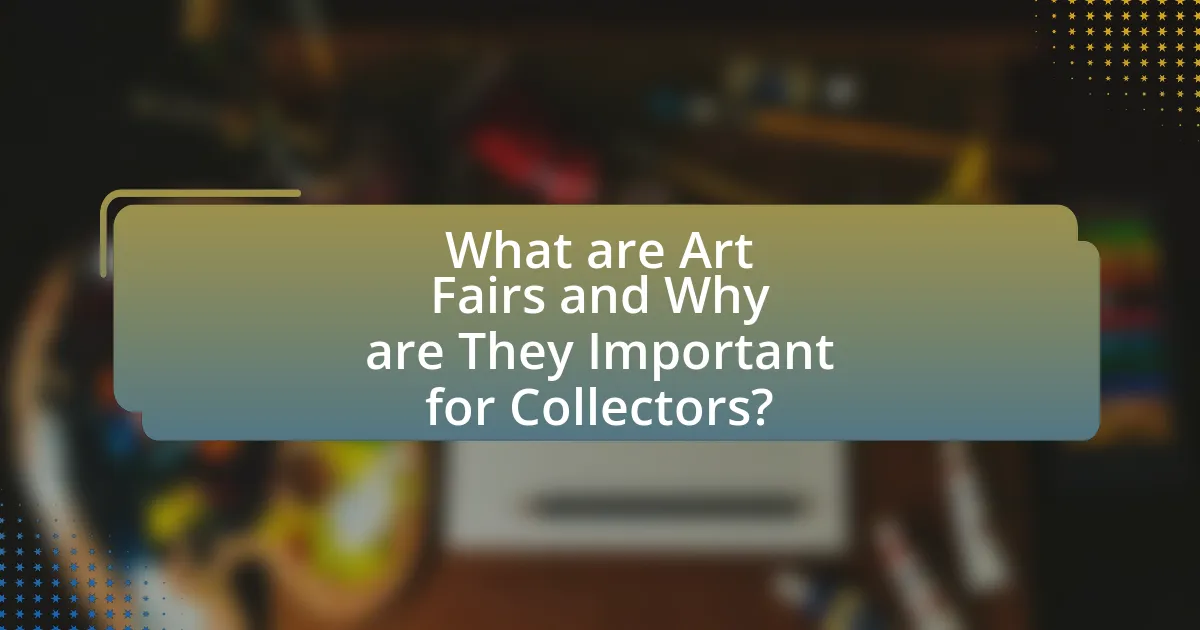
What are Art Fairs and Why are They Important for Collectors?
Art fairs are organized events where galleries and artists showcase and sell artworks to collectors and the public. They are important for collectors because they provide a unique opportunity to discover a wide range of artworks, meet artists and gallery representatives, and gain insights into current trends in the art market. Art fairs often feature a diverse selection of pieces, from established artists to emerging talents, allowing collectors to make informed purchasing decisions. Additionally, attending art fairs can enhance a collector’s network and knowledge, as these events often include talks, panels, and social gatherings that facilitate connections within the art community.
How do Art Fairs differ from other art events?
Art fairs differ from other art events primarily in their scale and structure, as they typically feature multiple galleries showcasing a wide range of artists and artworks in a single venue. Unlike solo exhibitions or gallery openings that focus on individual artists, art fairs present a curated selection of works from various galleries, allowing collectors to view and purchase art from numerous sources in one location. This format fosters a competitive environment, often leading to quicker sales and a more dynamic atmosphere. Additionally, art fairs often include programming such as panel discussions and artist talks, which are less common in other art events, enhancing the educational experience for attendees.
What types of artworks can be found at Art Fairs?
Art fairs feature a diverse range of artworks, including paintings, sculptures, photography, installations, and mixed media pieces. These events showcase works from both established and emerging artists, providing collectors with access to contemporary art trends and unique pieces. According to the Art Basel and UBS Global Art Market Report, art fairs have become a significant platform for art sales, with over 300 art fairs held globally each year, highlighting their importance in the art market.
How do Art Fairs contribute to the art market?
Art fairs significantly contribute to the art market by providing a platform for galleries, artists, and collectors to engage directly, facilitating sales and networking opportunities. These events showcase a diverse range of artworks, allowing collectors to discover new artists and trends, which can lead to increased sales for galleries. For instance, the Art Basel fair reported over $3 billion in sales across its events in 2019, highlighting the economic impact of such gatherings. Additionally, art fairs enhance visibility for emerging artists, often leading to representation by galleries and subsequent sales, thus driving the overall growth of the art market.
What should collectors consider before attending an Art Fair?
Collectors should consider their budget, the types of art they are interested in, and the reputation of the galleries and artists represented at the Art Fair. Establishing a budget helps collectors avoid overspending and allows them to focus on artworks that fit within their financial limits. Identifying specific interests, such as contemporary art or emerging artists, enables collectors to navigate the fair more effectively and engage with relevant exhibitors. Additionally, researching the reputation of participating galleries and artists ensures that collectors are investing in quality works, as reputable galleries often showcase established or promising talent.
How can collectors prepare for an Art Fair experience?
Collectors can prepare for an Art Fair experience by conducting thorough research on participating galleries and artists beforehand. This preparation allows collectors to identify specific artworks of interest and understand the market trends, as evidenced by the fact that informed collectors are more likely to make successful purchases. Additionally, creating a budget and setting clear goals for the fair can help collectors prioritize their time and resources effectively. Engaging with social media platforms and art publications can provide insights into the fair’s highlights and emerging artists, further enhancing the overall experience.
What are the costs associated with attending Art Fairs?
The costs associated with attending art fairs include admission fees, travel expenses, accommodation, and potential purchases of artworks. Admission fees can range from free to several hundred dollars, depending on the event. Travel expenses vary based on distance and mode of transportation, while accommodation costs depend on location and duration of stay. Additionally, collectors should budget for the artworks they may wish to purchase, which can range from a few hundred to millions of dollars. These costs can significantly impact the overall experience and investment in art fairs.
What are the key benefits of attending Art Fairs for collectors?
Attending Art Fairs provides collectors with access to a diverse range of artworks and artists, facilitating informed purchasing decisions. Collectors can view a wide variety of pieces in one location, allowing for comparison and exploration of different styles and mediums. Additionally, Art Fairs often feature emerging artists alongside established names, giving collectors the opportunity to discover new talent and invest early. Networking opportunities abound, as collectors can connect with gallery owners, artists, and other collectors, fostering relationships that can lead to future acquisitions. Furthermore, many Art Fairs offer educational programs, panel discussions, and guided tours, enhancing collectors’ knowledge about the art market and trends. These benefits collectively enhance the overall experience and value of attending Art Fairs for collectors.
How do Art Fairs facilitate networking opportunities?
Art fairs facilitate networking opportunities by bringing together artists, collectors, galleries, and industry professionals in a concentrated environment. This setting allows for direct interactions, fostering relationships that can lead to collaborations, sales, and partnerships. According to a report by Art Basel and UBS, 70% of collectors attend art fairs primarily to meet other collectors and professionals, highlighting the fairs’ role as a networking hub. Additionally, organized events such as panel discussions and VIP receptions at these fairs further enhance networking by encouraging dialogue and connection among attendees.
What advantages do collectors gain from direct interactions with artists and galleries?
Collectors gain several advantages from direct interactions with artists and galleries, including enhanced access to exclusive artworks, deeper insights into the creative process, and the opportunity to build personal relationships that can lead to future collaborations. Direct engagement allows collectors to acquire unique pieces that may not be available through traditional sales channels, as artists often reserve their best works for direct buyers. Furthermore, conversations with artists provide collectors with a richer understanding of the context and inspiration behind the artworks, which can enhance the value and appreciation of their collections. Additionally, establishing rapport with galleries can lead to early notifications about upcoming exhibitions and private viewings, giving collectors a competitive edge in the art market.
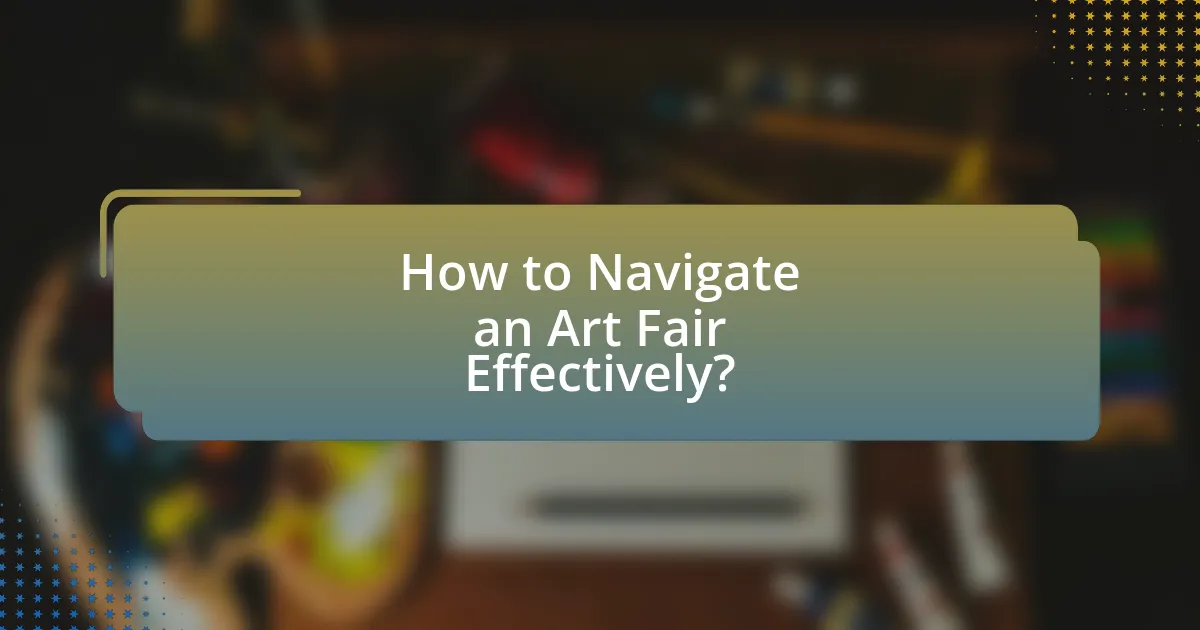
How to Navigate an Art Fair Effectively?
To navigate an art fair effectively, start by planning your visit in advance, which includes reviewing the exhibitor list and mapping out key booths to visit. This preparation allows you to prioritize galleries and artists of interest, ensuring you maximize your time at the event. Researching artists and their works beforehand can enhance your understanding and appreciation, making discussions with gallery representatives more meaningful. Additionally, setting a budget helps in making informed purchasing decisions without overspending. Engaging with the art community, attending talks or panels, and networking with other collectors can provide valuable insights and enhance your experience. Art fairs often feature a diverse range of works, so keeping an open mind while being focused on your interests can lead to discovering unexpected pieces.
What strategies can collectors use to maximize their Art Fair experience?
Collectors can maximize their Art Fair experience by conducting thorough research on participating galleries and artists prior to the event. This preparation allows collectors to identify specific works of interest and understand market trends, enhancing their ability to make informed purchasing decisions. Additionally, establishing a budget and prioritizing key artworks can streamline the experience, ensuring that collectors focus on their goals. Engaging with gallery representatives and artists during the fair fosters valuable connections and insights, which can lead to future opportunities. Collectors should also consider attending preview events, as these often provide first access to new works and exclusive offerings.
How should collectors prioritize galleries and artworks to visit?
Collectors should prioritize galleries and artworks to visit based on their personal interests, the reputation of the galleries, and the significance of the artworks. Personal interests guide collectors toward specific styles or periods, while the reputation of galleries often correlates with the quality and value of the artworks they exhibit. For instance, galleries that have a history of showcasing renowned artists or have received critical acclaim are likely to present more valuable pieces. Additionally, collectors should consider the significance of the artworks, such as those that are part of important movements or have historical relevance, as these can enhance their collections both aesthetically and financially.
What tools can help collectors track their interests during the fair?
Collectors can use mobile apps, spreadsheets, and note-taking tools to track their interests during the fair. Mobile apps like Artsy and ArtBinder allow collectors to catalog artworks, view artist information, and manage their collections in real-time. Spreadsheets can help organize details such as artist names, prices, and contact information, providing a customizable way to track interests. Note-taking tools like Evernote enable collectors to jot down thoughts and observations about specific pieces or galleries, ensuring they remember key details after the fair. These tools enhance the ability to make informed decisions and follow up on potential purchases.
What etiquette should collectors follow at Art Fairs?
Collectors should follow several key etiquette guidelines at art fairs to ensure respectful and productive interactions. First, collectors should arrive prepared with knowledge about the artists and galleries present, which demonstrates respect for the exhibitors and enhances meaningful conversations. Additionally, collectors should engage with gallery staff and artists politely, asking questions and expressing interest without monopolizing their time. It is also important for collectors to refrain from touching artworks unless permitted, as this shows respect for the pieces and the artists’ intentions. Furthermore, collectors should be mindful of their surroundings, avoiding loud conversations and maintaining a professional demeanor. Lastly, if a collector is interested in purchasing a piece, they should communicate their intentions clearly and follow up with the gallery after the fair, as this fosters good relationships within the art community.
How can collectors approach galleries and artists respectfully?
Collectors can approach galleries and artists respectfully by demonstrating genuine interest and knowledge about their work. This involves researching the artists and galleries beforehand, understanding their artistic styles, and being aware of current exhibitions or projects. Respectful engagement includes initiating conversations with thoughtful questions that reflect this knowledge, thereby showing appreciation for the artists’ efforts and creativity. Additionally, collectors should be mindful of the artists’ and galleries’ time, avoiding overly aggressive sales tactics or interruptions during busy events. This approach fosters a positive relationship and encourages open dialogue, which is essential in the art community.
What are common mistakes to avoid while attending an Art Fair?
Common mistakes to avoid while attending an Art Fair include not researching the exhibitors beforehand, which can lead to missed opportunities for discovering artists and artworks of interest. Attendees often overlook the importance of setting a budget, resulting in impulsive purchases that may not align with their collecting goals. Additionally, failing to engage with artists and gallery representatives can limit valuable insights about the artwork and its context. Lastly, neglecting to take notes or photographs can hinder the recollection of artworks and conversations after the event, making it difficult to follow up on potential acquisitions.
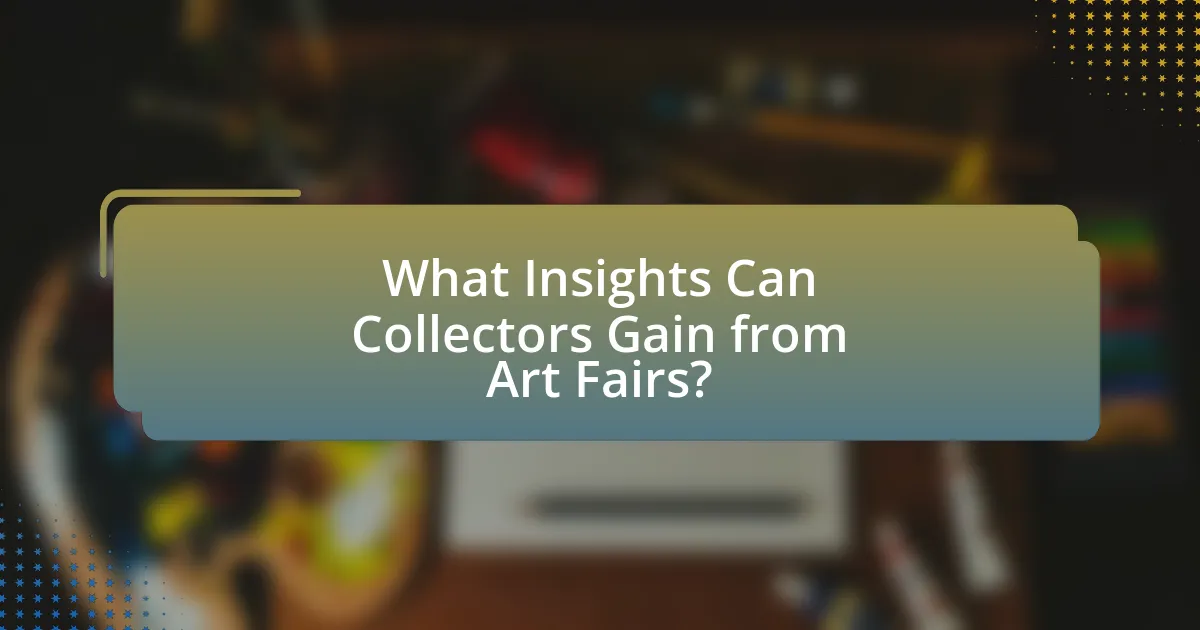
What Insights Can Collectors Gain from Art Fairs?
Collectors can gain valuable insights from art fairs, including trends in the art market, exposure to emerging artists, and networking opportunities with galleries and other collectors. Art fairs showcase a diverse range of artworks, allowing collectors to observe current market preferences and pricing strategies. For instance, the presence of specific styles or mediums can indicate shifting tastes among buyers. Additionally, collectors can discover new talent by engaging with emerging artists whose work may not yet be widely recognized. Networking at these events facilitates connections with galleries, which can lead to exclusive opportunities for acquiring sought-after pieces. Overall, art fairs serve as a comprehensive platform for collectors to enhance their understanding of the art landscape.
How can collectors assess the value of artworks at Art Fairs?
Collectors can assess the value of artworks at Art Fairs by analyzing factors such as the artist’s reputation, market demand, and comparable sales data. The artist’s reputation is crucial; established artists typically command higher prices due to their track record and recognition in the art community. Market demand can be gauged through the number of inquiries or interest shown by other collectors and galleries during the fair. Additionally, collectors should research recent sales of similar artworks, which provides a benchmark for pricing. For instance, auction results from reputable houses can offer concrete evidence of an artwork’s market value, helping collectors make informed purchasing decisions.
What factors influence the pricing of artworks at Art Fairs?
The pricing of artworks at Art Fairs is influenced by several key factors, including the artist’s reputation, the artwork’s provenance, market demand, and the overall economic climate. The artist’s reputation significantly impacts pricing, as established artists typically command higher prices due to their recognition and past sales history. Provenance, or the artwork’s history of ownership, can also enhance value, particularly if it has been associated with notable collectors or exhibitions. Market demand plays a crucial role; artworks that are in high demand can see inflated prices, while those that are less sought after may be priced lower. Additionally, the economic climate affects collectors’ purchasing power and willingness to invest in art, which can lead to fluctuations in pricing at Art Fairs.
How can collectors identify emerging artists and trends?
Collectors can identify emerging artists and trends by actively engaging with art fairs, galleries, and online platforms that showcase new talent. Art fairs often feature curated sections dedicated to emerging artists, providing collectors with direct access to innovative works and fresh perspectives. Additionally, following art publications and social media channels focused on contemporary art can reveal insights into rising stars and trending styles. For instance, platforms like Artsy and Artnet regularly highlight up-and-coming artists and their exhibitions, making it easier for collectors to stay informed. Engaging with art critics and attending panel discussions at these events can also enhance understanding of current trends and artist trajectories.
What are the best practices for following up after an Art Fair?
The best practices for following up after an Art Fair include promptly reaching out to contacts made during the event, sending personalized thank-you notes, and providing additional information about artworks of interest. Following up within a week ensures that the interaction remains fresh in the recipient’s mind, which is crucial for building relationships. Personalizing communication by referencing specific conversations or artworks discussed can enhance engagement and demonstrate genuine interest. Additionally, sharing relevant updates about the artist or gallery can keep the dialogue open and encourage future interactions. Research indicates that timely and personalized follow-ups significantly increase the likelihood of successful networking outcomes in art-related events.
How should collectors maintain relationships with galleries and artists post-fair?
Collectors should maintain relationships with galleries and artists post-fair by regularly communicating and engaging with them. This can include sending follow-up emails to express appreciation for their work, sharing thoughts on pieces acquired, and inquiring about future exhibitions or events. Establishing a consistent dialogue fosters trust and keeps collectors informed about new opportunities. Research indicates that ongoing communication can enhance relationships in the art world, as it demonstrates genuine interest and commitment to the artists and galleries.
What steps can collectors take to evaluate their purchases after the fair?
Collectors can evaluate their purchases after the fair by conducting thorough research on the artworks, verifying the provenance, and assessing the condition of the pieces. Researching involves checking the artist’s background, market trends, and comparable sales to understand the value of the purchase. Verifying provenance ensures that the artwork has a documented history, which can affect its authenticity and value. Assessing the condition includes examining any damage or restoration work that may impact the artwork’s worth. Collectors can also seek expert opinions or appraisals to gain additional insights into their acquisitions.
What practical tips can enhance a collector’s experience at Art Fairs?
To enhance a collector’s experience at Art Fairs, collectors should plan their visit by researching participating galleries and artists in advance. This preparation allows collectors to prioritize which booths to visit based on their interests and budget. Additionally, setting a budget beforehand helps collectors make informed purchasing decisions without overspending. Engaging with gallery representatives and artists can provide valuable insights into the artworks, enhancing the overall experience. Collectors should also take notes and photographs of artworks they are interested in, as this aids in recalling details later. Networking with other collectors can lead to valuable connections and insights into the art market. Lastly, attending talks or panel discussions at the fair can deepen understanding of current trends and practices in the art world.
How can collectors effectively manage their time during the fair?
Collectors can effectively manage their time during the fair by creating a detailed schedule that prioritizes key booths and events. This approach allows collectors to allocate specific time slots for visiting galleries, attending talks, and networking, ensuring they maximize their experience. Research indicates that having a structured plan can enhance decision-making and reduce the feeling of being overwhelmed, which is common in large-scale events. By identifying must-see exhibitors in advance and setting time limits for each visit, collectors can navigate the fair efficiently and make informed purchasing decisions.
What resources are available for collectors to stay informed about upcoming Art Fairs?
Collectors can stay informed about upcoming Art Fairs through various resources such as dedicated art fair websites, newsletters, and social media platforms. Websites like Art Basel, Frieze, and The Armory Show provide comprehensive calendars and updates on their events. Additionally, subscribing to newsletters from art institutions and galleries can deliver timely information directly to collectors. Social media platforms, particularly Instagram and Facebook, are also effective for real-time updates and announcements from art fairs and participating galleries. These resources collectively ensure that collectors have access to the latest information regarding Art Fairs.










